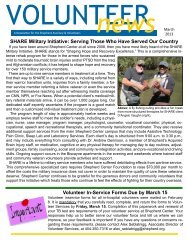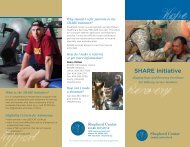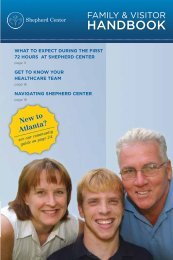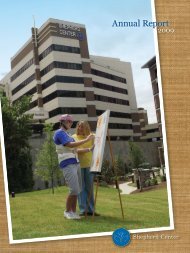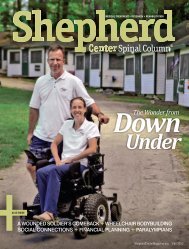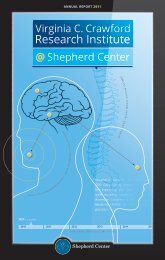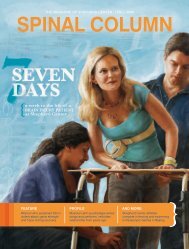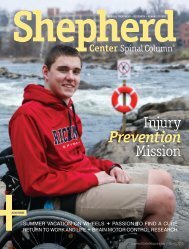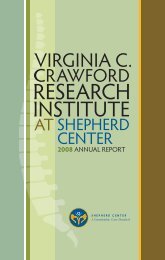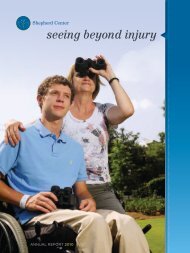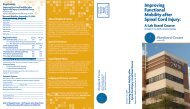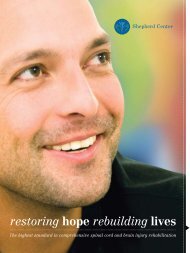the BRAIN - Shepherd Center
the BRAIN - Shepherd Center
the BRAIN - Shepherd Center
You also want an ePaper? Increase the reach of your titles
YUMPU automatically turns print PDFs into web optimized ePapers that Google loves.
Research<br />
It’s an exciting time for neuroscience, including <strong>the</strong> hope for<br />
new <strong>the</strong>rapies to treat spinal cord injury (SCI). While basic<br />
scientists and clinicians are making important advances, <strong>the</strong>y<br />
face daunting challenges when it comes to moving promising<br />
research from <strong>the</strong> bench to <strong>the</strong> bedside.<br />
To identify and address <strong>the</strong>se barriers, leading experts in neuroscience<br />
and stem cells recently came toge<strong>the</strong>r for <strong>the</strong> one-day<br />
workshop at <strong>the</strong> University of Georgia.<br />
“The concept of this workshop grew out of a need for better<br />
communication between stem cells scientists, who dared to use<br />
<strong>the</strong> term ‘cure’ for spinal cord injury, and care providers, who are<br />
worried about raising ‘false hopes’ and setting unrealistic goals<br />
for people with spinal cord injury,” says Ann Kiessling, Ph.D.,<br />
associate professor of surgery at Harvard Medical School and<br />
director of <strong>the</strong> Bedford Stem Cell Research Foundation, which<br />
organized <strong>the</strong> second annual ga<strong>the</strong>ring in cooperation with<br />
<strong>Shepherd</strong> <strong>Center</strong>. “Both groups clearly have <strong>the</strong> patient’s best<br />
interest at heart, but were not hearing each o<strong>the</strong>r’s concerns.”<br />
A key challenge for people with SCI is <strong>the</strong> concern among<br />
clinicians that any direct intervention at <strong>the</strong> site of <strong>the</strong> injury<br />
could impose fur<strong>the</strong>r damage and additional loss of function,<br />
Dr. Kiessling says. “They are understandably reluctant to expose<br />
<strong>the</strong>ir patients to <strong>the</strong> risk of fur<strong>the</strong>r spinal cord damage for<br />
research purposes,” she adds.<br />
There is also a lack of infrastructure within <strong>the</strong> SCI research<br />
community to support multi-center studies, and to define how<br />
studies in SCI can be made safe and relevant to human patients.<br />
Keith Tansey, M.D., Ph.D., director of spinal cord injury research<br />
at <strong>Shepherd</strong>, spoke to <strong>the</strong> group about <strong>the</strong> need to ensure<br />
animal studies are more relevant to humans.<br />
“Humans aren’t necessarily just big rats, and we need to better<br />
understand how and why animals are recovering from SCI<br />
because <strong>the</strong> mechanisms may not be <strong>the</strong> same in humans,”<br />
Dr. Tansey says. “Studies of animals and humans with incomplete<br />
injuries reveal a bias toward spinal plasticity in animals<br />
and brain plasticity in humans as <strong>the</strong> reason for functional<br />
recovery, so treatments may need to be different. In complete<br />
injuries, spinal circuits in rodents can regain stepping, but<br />
humans can’t, so we need to learn how to make human spinal<br />
cords function like rats’.”<br />
Dr. Kiessling agrees, adding that animal model research needs<br />
to be more carefully aligned with human injuries and <strong>the</strong> outto<br />
Bedside<br />
From Bench<br />
Leading experts in basic science and clinical care discuss barriers to a “cure”<br />
for spinal cord injury. By Amanda Crowe, MA, MPH<br />
come goals for human <strong>the</strong>rapies. “If walking is <strong>the</strong> outcome<br />
measure, animal models need to reflect that. But if bladder<br />
control is what’s important, a different animal model may be<br />
needed,” she says.<br />
Researchers and clinicians must gain a better understanding<br />
of how much recovery is due to re-establishment of brainspinal<br />
cord connections versus improvements in interpreting<br />
and using sensory information in <strong>the</strong> spinal cord below <strong>the</strong><br />
level of injury. Dr. Tansey challenged <strong>the</strong> traditional view of<br />
translational research in which discoveries at <strong>the</strong> cellular level<br />
move from <strong>the</strong> lab to clinical practice, arguing that it should<br />
be more of a two-way street. That is, questions that arise in <strong>the</strong><br />
clinical setting can go back to <strong>the</strong> lab to find answers. O<strong>the</strong>r<br />
attendees said this model could help inspire greater communication<br />
and partnership, as well.<br />
A memorable highlight of <strong>the</strong> workshop was a tour of<br />
<strong>Shepherd</strong> <strong>Center</strong>, <strong>the</strong> only specialty rehabilitation center in<br />
<strong>the</strong> country that combines intensive medical care, rehabilitation<br />
and a clinical research program under one roof. This visit<br />
gave basic scientists a chance to see what <strong>the</strong>ir work can do at<br />
<strong>the</strong> human level, well beyond studying cell biology in <strong>the</strong> lab.<br />
“We could have held this workshop anywhere in <strong>the</strong><br />
country, but we were impressed by <strong>the</strong> clear enthusiasm and<br />
determination of <strong>Shepherd</strong>’s leadership, particularly Alana<br />
<strong>Shepherd</strong>, in creating a unique center of excellence in patient<br />
care,” Dr. Kiessling says.<br />
Still, experts say <strong>the</strong> complexity of SCI cannot be overstated,<br />
and <strong>the</strong>re is no silver bullet – no single cell, no single<br />
surgery, no single nerve-growth factor that will solve <strong>the</strong><br />
whole riddle. “The more realistic expectation is that a combination<br />
of incremental steps is needed to improve recovery and<br />
maximize function,” Dr. Tansey says. “There is huge potential<br />
with stem cell biology and cell-replacement <strong>the</strong>rapies, but<br />
<strong>the</strong>re’s also a long distance between where we are today and<br />
where we need to be to find a ‘cure.’”<br />
Collaborations among <strong>the</strong>se leading experts will help<br />
forge <strong>the</strong> path forward. In <strong>the</strong> meantime, patients and <strong>the</strong>ir<br />
families should be encouraged by <strong>the</strong> progress made thus far,<br />
experts say. Prevention and early intervention, regeneration<br />
<strong>the</strong>rapies at <strong>the</strong> cellular and extra-cellular levels and aggressive<br />
rehabilitation are all contributing to significant neurological<br />
recovery after SCI.<br />
2 0 Spinal Column<br />
w w w. s h e p h e r d . o r g



